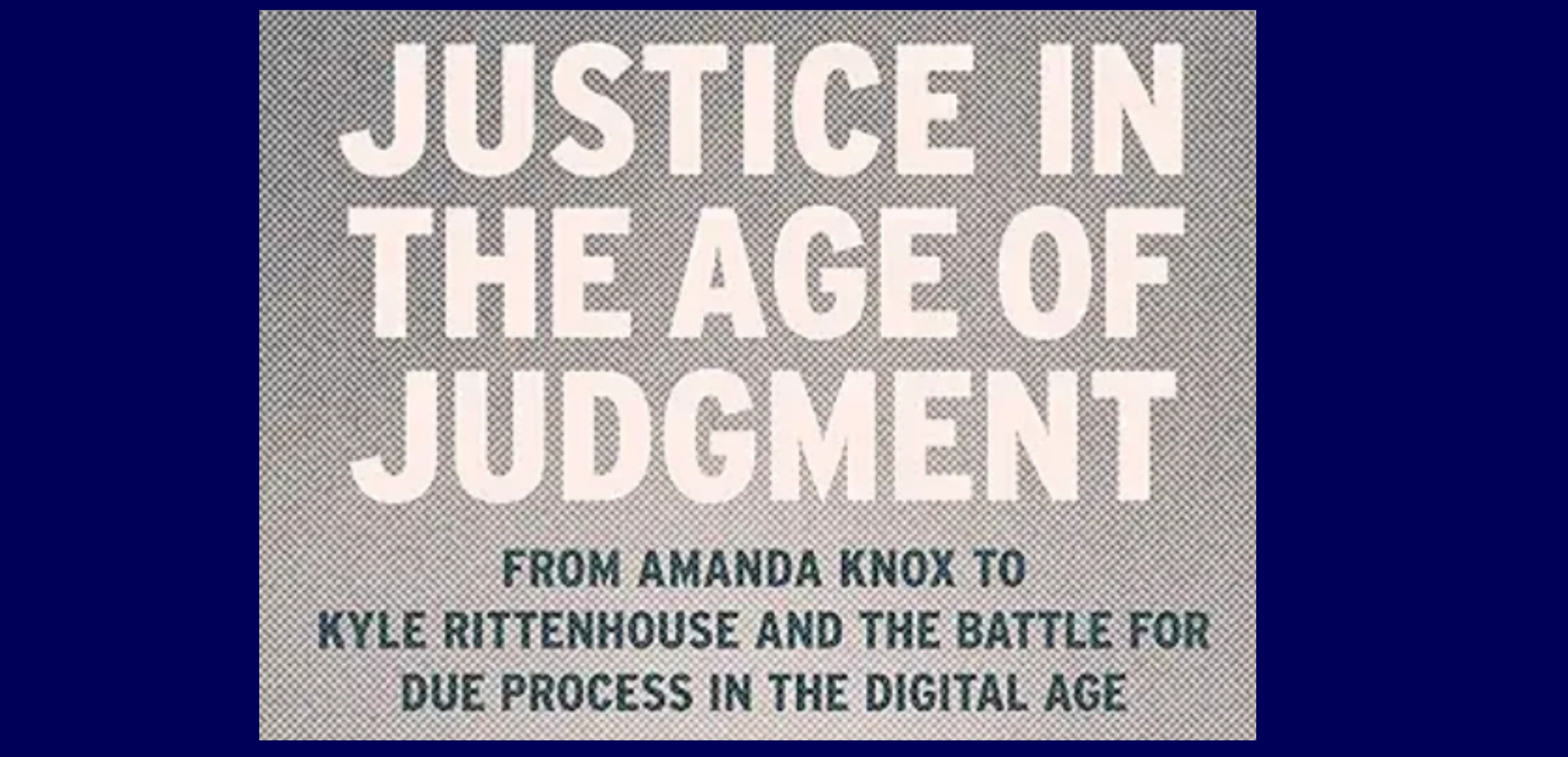
Friday, February 28, 2025
Promo Of New Book By Knox Groupie Anne Bremner Stands Corrected
Posted by James Raper
Fact Checking
Some of you may, or may not, have read Seattle lawyer Anne Bremner’s book “Justice in the Age of Judgement”. I have not bothered but I have read the Preface to the book.
As she herself admits the book is really all about Amanda Knox, although the theme she espouses as being central, not just to Knox’s case but to others as well, is that the media - and social media - have a corrupting and pernicious effect on the conduct of criminal investigations and the outcome of jury trials.
Apparently she goes on to demonstrate how true this has been in other notorious cases which she has, apparently, researched.
Now she may just have a point about the media, and social media, but positing that as an explanation for the fact that Knox was convicted twice on the charge of murder, and five times on the charge of criminal defamation, and as validation for everything Bremner has ever said or written about Knox’s case, is trite and perverse, and hypocritical as well.
Trite and perverse is a summary of her character, and of her lack of diligence in researching and owning up to the facts of the case. This is patent from reading the Preface, and in what follows I will quote directly from it.
“My name is Anne Bremner. I am a lawyer from Seattle. In 2008 I was asked by an esteemed judge and his longtime colleague if I would be willing to help to defend a Seattle college student accused of the brutal murder of her roommate while studying abroad in Italy”
The “esteemed judge” was, of course, Michael Heavey.
“…… her friends and family insisted that she was wrongly accused and innocent. When they told me the horrifying details, which involved a forced confession, a prejudiced and compromised investigation, and a seemingly irrational prosecutor hell bent on convicting Amanda regardless of the facts, I more than willingly jumped in and agreed to help.”
Jumped in, yes, head over heels, in giddy excitement at perceiving an opportunity for thrusting herself forward into the limelight again – and she has never looked back or subjected herself to any sober reflection on the extent of the overwhelming evidence in the case, other than to parrot FOA mantras, which is what the above and a lot of the rest of the book is about.
She gives us a bit more detail about how she took on the case.
“I saw a call coming in from Mike Heavey. Mike was a judge for the King County Superior Court, where I had presented cases many times.”
“Anne, you probably heard about this Amanda Knox case, right?”
“You mean the student from Seattle who was charged with murdering her roommate in Italy?”
“I think there’s been a real travesty of justice here. You’re a lawyer who has a lot of exposure in the media. I think you can really help us.”
“Mike went on to explain how there was no evidence against Amanda, how it was improbable that someone whose life had been exemplary could – out of the blue – commit such a horrible crime. And how the police and prosecutors in Perugia, Italy – where she was undergoing hearings under seal – were leaking false information and mistreating her. Thus far they had –
• Subjected her to hours of abusive interrogation, even hitting her on the head to coerce a confession
• Leaked her diary
• Lied to her by saying that she had been infected with ……HIV.
• Used false information to get her to make a list of men she had slept with.
• Used that list to try to paint her as a wicked slut, a siren who used sex to lure men to their demise.”
There are already some errors and things here which do not make any sense. which she would have noticed had she bothered to check and think about it.
This phone call from Mike Heavey, she says, was in 2008 which is before the start of Knox’s trial which commenced in 2009. As for “a travesty of justice”, whether there has been one or not rather depends on whether the accused is guilty or innocent. which is what is decided by a trial, so there had been no travesty of justice at the time of the call.
There was, however, a public relations battle to be fought with the American public, and in engaging with the public through her chosen oulets (mostly on TV, that is) Bremner has been blithely promulgating her own pernicious distortion of the facts of the case, which is continued in this book and which behaviour is precisely what, with her staggering lack of insightfulness, she has been accusing the media of! But who needs facts when it matters not, in the court of public opinion, if you get them wrong? Hypocrisy.
There had, of course, not been a confession as such but a false allegation against an innocent man. There had not been hours of abusive interrogation. In what way, in the circumstances of this case, was Knox a siren who used sex to lure men to their demise?
And then this -
“On Halloween night, 31st October, 2007, …….. Amanda and Raffaele were holed up in his apartment, smoking weed and making love. Amanda was scheduled to go to work at a bar owned by Patrick Lumumba…….. but she got a text saying he didn’t need her that night. Relieved, she spent the the rest of the night at Raffaele’s. The next morning, she returned home and took a shower. Finding the door of her roommate locked and not getting a response, she called Raffaele, who came over and tried to break the door down, without success. They called the police, who arrived and broke it down. That’s when they found the body of Meredith.”
The above might sound somewhat non-contentious but how many mistakes can you count in this brief introduction to the case? I can count four.
What she says would mean that the discovery of the murder happened on the 1st November, whereas, of course, that discovery occurred on the 2nd November. Amanda did not call Raffaele. There is no log of such a call on that day. Raffaele called the Carabinieri but it was not the Carabinieri who arrived but the Postal Police. It was not the police who broke down Meredith’s door, but Altieri.
Bremner has had 17 years in which to research the basic facts of the case, and she cannot even get some of these basic facts right.
“In retrospect, I realize Amanda’s case was a forerunner of things to come. Her trial was not a trial of law, but of trial by media, convicted by the internet, before she even had a chance to present evidence or hear witnesses Her guilt was not decided by a jury of her peers, but by her facial expresssions and calisthenics. I called Amanda’s case “a conviction based on kisses and cartwheels”. That is what this book is about.”
In the court of public opinion? Too right. That’s exactly what the book is about. A litany of distorted facts and conjectures that would be hilarious if not so tragic and pathetic. What has any of this to do with the actual evidence produced in an actual court of law, and in respect of which the Italian criminal justice system requires the publication of a detailed report (Motivation) to explain exactly how and why the verdict has been reached? Has Bremner ever bothered to read and absorb any of these?
“At the initial investigation of the crime scene, Raffaele was hugging and comforting Amanda, which led Mignini to decide she was a sex-obsessed sociopath who didn’t care about Meredith’s death. Amanda and Raffaele were brought to the police station separately. They found a text message to Patrick on Amanda’s phone, which led Mignini to conclude Patrick was involved.
What followed was forty-three hours of tag-team police interrogation in Italian (in which Amanda was far from fluent), where she was hit on the head and yelled at to remember! She was asked to imagine what it would have been like to be there with Patrick and Raffaele and hear the screams of the dying Meredith.”
How many distorted facts and absurd conjectures are there here? From where does Bremner get the idea that Mignini decided Amanda was a sex-obsessed sociopath? Apparently from the behaviour described above? Really?
Amanda and Raffaele were not brought to the police station separately, either on the day of the discovery of the murder (the 2nd), or on the day of the discovery of the text on her phone and the so-called “confesssion” (the 5th & 6th).
The police did not conclude that Patrick was involved, and arrest him, just because of a text message, but because Knox said he was.
“What followed was not 43 hours of tag-team interrogation.” There is absolutely no evidence for such an assertion. The critical part of the questioning occurred on the arrival of the Interpreter at 12.30 am on the morning of the 6th (that timing coming from both the Interpreter, Anna Donnino, and from Knox herself) and it was then that the text Knox had sent to Patrick was discovered on her phone.
Knox then accused Patrick of the murder and signed a statement to that effect at 1.45 am. That’s one and a quarter hours later. Hardly 43 hours of tagteam interrogation. In fact Knox had not been anywhere near the police station on the 5th until she arrived, unrequested, at about 11.30 pm.
Can anyone with a scrap of common sense give any credence to the idea that Knox was asked to imagine a murder scene at which she had to imagine that she was present, and that she then actually went along with such nonsense, signing two statements, 4 hours apart from each other, which falsely accuse Patrick of the murder? Would you do that? Would anyone? If you had nothing at all to do with the murder, not even being anywhere near where it occurred, wouldn’t you have to be a complete and utter moron to have anything to do with any of that?
All concocted FOA mantras and gibberish. And so it goes on. You get the picture, and don’t need to read on. So I will leave it there. The book is a joke.
***
If readers would like to access my own deeply researched book, then they can in fact do it here on the TJMK website. Look at the left hand column and click on “The Best Resources”. This will take you to a page the first article of which has, in the heading, a foreshortened picture of the cover to my book “Justice on Trial”. Click on the picture to read it or to download the PDF to read at your leisure.

